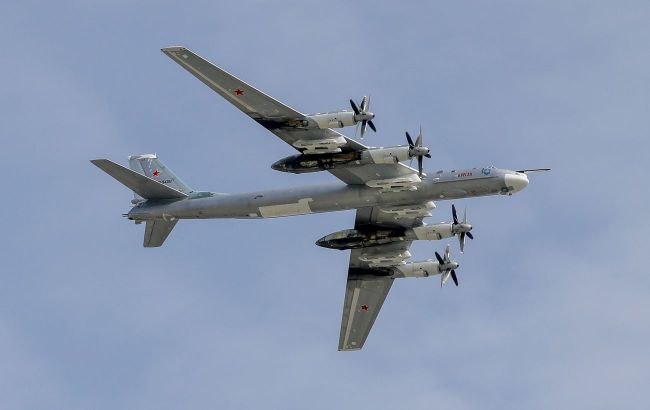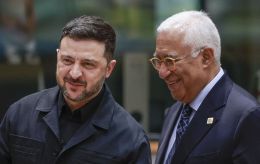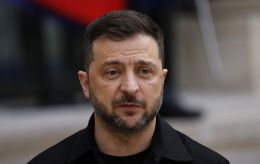Dangerous period: Why Russia imitates launches from Tu-95MS
 Photo: Russia has resorted to simulating a missile attack from strategic aviation (Getty Images)
Photo: Russia has resorted to simulating a missile attack from strategic aviation (Getty Images)
In the morning, Russia flew Tu-95MS and MiG-31K aircraft to simulate a massive attack. Although Russia did not launch any missiles, preventive blackouts were introduced in many regions of Ukraine to protect the energy sector.
What this means, why Russia needs to simulate a strike, and when to expect massive shelling is described in the RBC-Ukraine article below.
Russia's imitation of massive missile strike on Ukraine
Around 3 a.m. Kyiv time, Russians took off with Tu-95MS bombers. Later, Mig-31K Kinzhal carriers took off. At dawn, the Air Force even reported cruise missile launches from the Caspian Sea. This caused a large-scale air raid in Ukraine.
According to Oleksandr Kovalenko, a military and political observer of the Information Resistance group, the Russians took 16 Tu-95MS into the air, namely 11 aircraft from the Olenya airfield and 5 from Engels-2.
“According to the capabilities of Russian aviation, those that took off from Olenya were able to carry an average of 2 missiles per side. That is 22 missiles. The ones that took off from Engels were able to carry 2 to 4 missiles per plane. Because the distance also affects the load. So, there could have been either 10 or 20 missiles,” Kovalenko explains.
According to the expert, this suggests that Russia could have used 30 to 50 missiles in total during the launches. At the same time, MiG-31Ks took off in the amount of 3 units from the Privolzhsky airfield. This means 3 more Kinzhal missiles.
However, the launches of strategic aviation missiles were not confirmed. According to the monitoring channels, the bombers performed a training flight, reaching the launching lines and carrying out simulated launches. So, around 9 a.m. Kyiv time, the alarms began to sound.
However, in Kyiv and many regions, to protect the power system from the possible, preventive blackouts were announced. As Ukrenergo explained, the emergency blackouts introduced in the morning in most regions were temporary and will be canceled soon.
Russia's goal
As noted by the Center for Countering Disinformation, Russia's practice of simulated launches is part of keeping aviation ready for action. Another goal of the enemy is psychological pressure.
“As I said, the Russians have everything ready for massive shelling. There are enough missiles, they are accumulated at strategic aviation airfields and are still being accumulated. The aviation is also ready,” Kovalenko says.
The network also began to spread the thesis that such an imitation of a massive shelling could be a signal from Russian dictator Vladimir Putin to US President-elect Donald Trump that he wants to continue talking with him “about Ukraine without Ukraine.” However, the Kremlin itself denies that such a conversation took place.
“If we look at these almost 3 years of war, how Russian launches are taking place, and so on, we have repeatedly seen not only MiG-31s but also Tu-95MSs take off, go to launch sites, and then return. This has happened many times. Therefore, I would not associate this with the demonstration (of Putin for Trump - ed.),” Kovalenko says.
He notes that it is too early for Putin to demonstrate anything to Trump. After all, there are still two and a half months before the inauguration of the newly elected president.
“Therefore, if something is to be demonstrated, it would be appropriate to demonstrate it in January. And now it was rather a kind of preparation, working out routes for further missile terror against our energy system,” Kovalenko adds.
Russian massive missile attack
According to the expert, this season, Russian occupiers will be more rational in their approach to massive missile attacks than they did in 2022 and 2023.
“Although in 2023 they did improve their strike rates, unfortunately. It's not that they learned how to do it, but they started to make these strikes more effective than they were in 2022,” the source says.
He does not rule out that this year Russian troops will use new elements in these strikes that will increase their effectiveness. Among other things, there are fears that they will launch these strikes when the frost begins.
“This is logical. It's too early for them to do this now. And the frosts are not like two or three days of -5, 0 degrees, and then +5 +7 again. No. It's just according to the forecast when these frosts can last for several weeks. That is, -10 to -15 degrees when there is a corresponding load, an overload of the power system. This will be a more dangerous period,” Kovalenko says.
However, in any case, if Russians are brainwashed by something, they can launch missiles tomorrow. That is, Russia is unpredictable in this matter, the expert adds.
Before that, Russian troops launched dozens of Shaheds and 2 Kh-59/69 guided missiles at Ukraine at night. Ukrainian air defense forces shot down 39 out of 74 Russian drones and 2 missiles, and another 30 drones were lost locally.
However, there were consequences. A nighttime Russian drone attack killed at least five people in Mykolaiv. In addition, at least one person was killed and 22 others were injured in Zaporizhzhia, which was hit by Russian drone strikes.
Sources: Air Force of the Armed Forces of Ukraine, Kyiv City Military Administration, monitoring channels, Ukrenergo, the Center for Countering Disinformation, an exclusive commentary by Oleksandr Kovalenko, military and political observer of the Information Resistance group.

